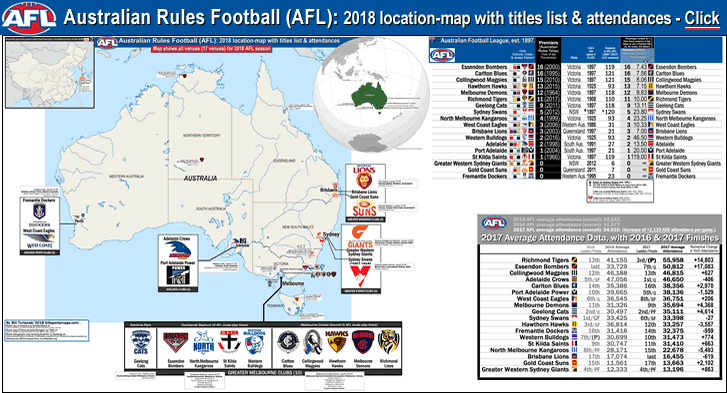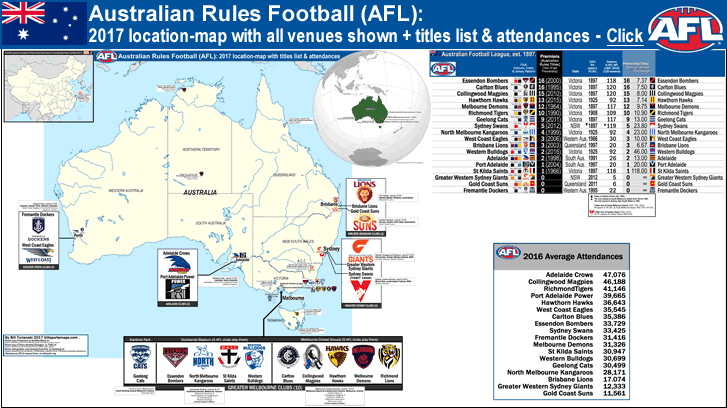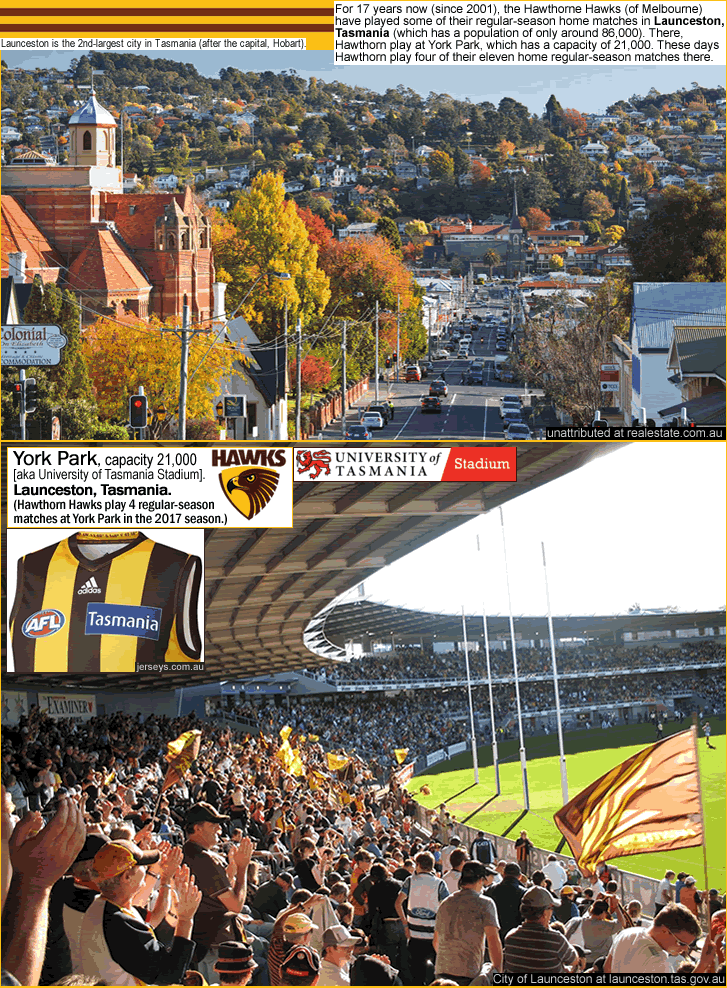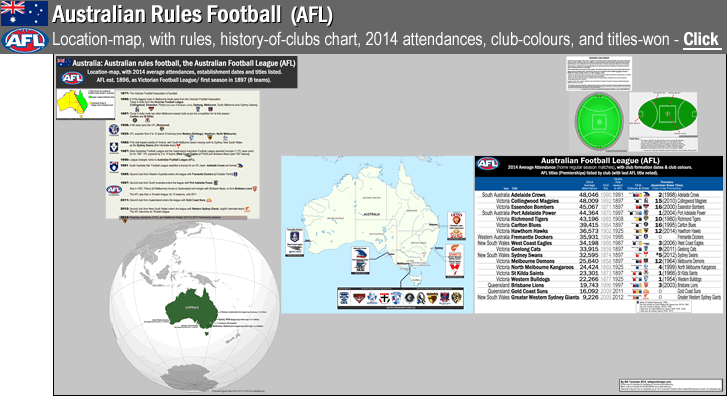
AFL (Australia): Australian Rules Football’s 1st division – map, with brief league history, 2014 attendances, and club titles listed
…
…
Links…
-Teams…Australian Football League/Current clubs (en.wikipedia.org).
-Live scores…scoreboard.com/aussie-rules.
-Fixtures & Results (official site)…afl.com.au/fixture.
-Official website…afl.com.au.
Australian Football League: 2015 location-map with: Rules (in general), Clubs-history-chart; Attendances, Club colours, and Titles listed
By Bill Turianski on 11 April 2015; twitter.com/billsportsmaps.com.
Update -
Please note: here is an “update” I posted in 2016 (on the 2015 season of the AFL),
AFL attendance chart for 2015 regular season (with 2015 finishes listed)/+ the Hawthorn Hawks – 2015 AFL Premiers [champions] (their 3rd-straight title, and 13th overall) (billsportsmaps.com, posted on 21 March 2016).
First off, apologies to all the regulars from Down Under who have waited patiently (over 7 years) for me to finally make a map and a post of an Australian pro league. I will also soon have a post, in the near future (around mid-May 2015), for Australian rugby league football (the NRL).
On the map page…
At the top left-hand side of the map page is a Clubs-formation chart which shows a brief history of the VFL/AFL, with each current clubs’ date of inclusion into the league noted. At the lower left is a globe-map of Australia, with the 5 largest cities noted. At the center of the map page is a location-map of the 18 AFL teams. At the upper right-hand side of the map page are two illustrations of the typical Australian rules field, with a brief rules description and a brief word on typical-playing-field-dimensions (there also is a section below, on rules/playing-field/traditional-positions). Below that is a chart which shows 2014 home regular season attendance for the 18 AFL clubs, with three other things listed…1). club’s dates of formation and of inclusion into VFL/AFL; 2). club colours, crest, and jersey-pattern; 3). Premiers (titles) won by each club (with date of last title noted).
Size and population of Australia…
I will start of with a brief description of the size, relative size, and population of Australia. If you click on the following link you can see, at a glance, how large the island/Continent of Australia is when it is compared to the Continental USA, {here (aboutaustralia.com)}. As you can see in that graphic, Australia is about the same size as the Continental USA, but when you factor in Alaska (and Hawaii), Australia ends up being about 23% “smaller” than the 50 United States. Australia is the 6th-largest country on Earth, at around 7.6 million km-squared (or around 2.9 million miles-squared), which makes it about 10% “smaller” than the 5th-largest country – Brazil, and more than twice the size of the 7th-largest country – India. To put it another way, Australia is massive. It is also not very populous for its size, because Australia is only the 52nd-most-populous nation, with a population of around 23.7 million {2015 figure}. To give you an idea of how sparsely populated Australia is, it has slightly less inhabitants than the pretty-small-sized nations of Nepal, Ghana, or North Korea. {Sources of data: sizes: List of countries and dependencies by area; populations: List of countries and dependencies by population (both from en.wikipedia.org).}
The Big 5 Cities in Australia…
There are 5 major cities in Australia, all of which have AFL teams. On the map page, in the globe-map on the lower left there, I have placed those 5 cities along with their populations. Sydney is the largest city in the country, with around 4.7 million inhabitants (in the metro area/urban population/all listed here are 2013 or 2014 estimates). Melbourne is the second-city of Australia – but only just…it has a population of only about 300 K less than Sydney, at around 4.4 million. Brisbane is third-largest, at about 2.3 million; Perth is fourth at around 2.0 million; and Adelaide is fifth at around 1.2 million. The capital of Australia, Canberra (which is situated in the small Australian Capital Territory, located midway between Sydney and Melbourne) is a rather small city, and is the eighth-largest, with about 411,000 inhabitants. {Sources, each city’s Wikipedia page for the most-recent population estimates, however the following link is relatively recently updated (2012 figures), List of cities in Australia by population (en.wikipedia.org).}
…
There are 4 football codes in Australia which have professional major leagues (the most of any country)…
There are 4 football codes in Australia (listed below with first-division 2014 league-average-attendances):
Australian rules football (1st division: AFL, which averaged 32,327 per game in 2014).
Rugby union football (1st division: Super Rugby, which averaged 16,913 per game in 2014).
Rugby league football (1st division: NRL, which averaged 15,787 per game in 2014).
Association football [aka soccer]: only pro division: A-League, which averaged 14,759 per game in 2014).
[source: http://en.wikipedia.org/wiki/2014_Australian_football_code_crowds#Attendances_by_league.]
An extremely simplified guide to the 4 football codes’ popularity in Australia…
Aussie rules football…
[please note: a very basic VFL/AFL history is shown at the top left-hand-side of the map page.]
To simplify it in the extreme, Australian Rules Football, which originated in the 1860s in and around Melbourne in the state of Victoria, turned semi-pro when the AFL was formed in 1897. Although first division teams were not based in any of the other states and territories of the country for almost 90 years (until the 1980s and 1990s), Aussie rules football has always been hugely popular throughout all the 8 states and the 2 territories of Australia, with the exception of New South Wales (NSW) and Queensland. In and around Sydney (which is the capital of New South Wales) and in all of Queensland (including Brisbane), Australian rules football has been historically overshadowed by rugby league football. The split described in the last two sentences can be see in the map at Barassi Line (en.wikipedia.org) {that map is also at the top-left-hand-side of the map page}.
The 2 Rugby codes in Australia…
Rugby Union, a little over a century ago, became the major sport of the city of Melbourne and of the state of Victoria. The highest level of competition in Australia is the National Rugby Championship, although there is a higher tier that involves teams from South Africa, New Zealand, and Australia, Super Rugby.
Rugby League, a little over a century ago, became the major sport of the city of Sydney and of the state of New South Wales (as well as the major sport of Brisbane in Queensland). The highest level of competition in Australia is the National Rugby League (NRL), which has 16 teams (9 teams from New South Wales).
Soccer (aka association football), in Australia…
Soccer was widely shunned by many if not most Australian fans and players for decades (ie, only “Sheilas, Wogs & Poofters” played soccer, as the bigotry of the day held [circa 1950s through '80s]). Only in the last decade-and-a-half or so has soccer become a viable pro sport in Australia. And now, going into the 2010s, soccer has made significant gains in popularity, to the point that the Australian first division in soccer (the A-League) is currently drawing only marginally less than both rugby codes in the country (see list with league-attendance 4 paragraphs above).
…
Australian Rules Football: Rules (in general), Field Size, and Traditional Positions…
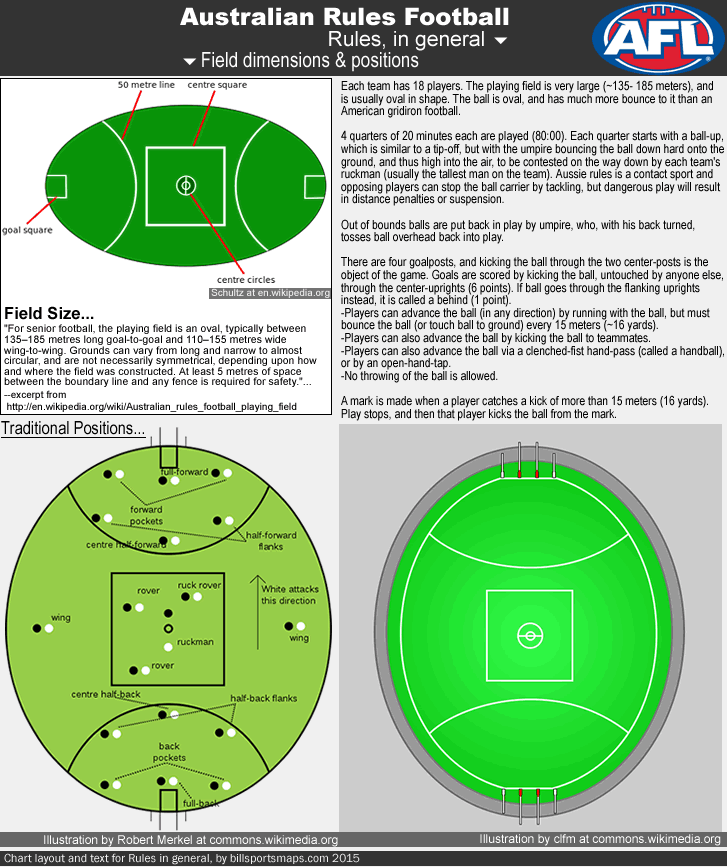
Image credits above – Field markings on the oval, illustration by Schultz at File:Footygroundfix.svg (en.wikipedia.org). Traditional positions in Aussie rules, illustration by Robert Merkel at File:Aussie rules ground positions.svg. Typical oval, illustration by clfm at File:AFL stadium.svg (commons.wikimedia.org).
Australian Rules Football: Rules (in general)…
[Note: the text below is the same as the text in the upper-right-hand-part of the illustration above.]
Each team has 18 players. The playing field is very large (~135 to 185 meters), and is usually oval in shape. The ball is oval, and has much more bounce to it than an American gridiron football. 4 quarters of 20 minutes each are played (80:00). Each quarter starts with a ball-up, which is similar to a tip-off, but with the umpire bouncing the ball down hard onto the ground, and thus high into the air, to be contested on the way down by each team’s ruckman (usually the tallest man on the team). Aussie rules is a contact sport and opposing players can stop the ball carrier by tackling, but dangerous play will result in distance penalties or suspension.
Out of bounds balls are put back in play by umpire, who, with his back turned, tosses ball overhead back into play.
There are four goalposts, and kicking the ball through the two center-posts is the object of the game. Goals are scored by kicking the ball, untouched by anyone else, through the center-uprights (6 points). If ball goes through the flanking uprights instead, it is called a behind (1 point).
-Players can advance the ball (in any direction) by running with the ball, but must bounce the ball (or touch ball to ground) every 15 meters (~16 yards).
-Players can also advance the ball by kicking the ball to teammates.
-Players can also advance the ball via a clenched-fist hand-pass (called a handball), or by an open-hand-tap.
-No throwing of the ball is allowed.
A mark is made when a player catches a kick of more than 15 meters. Play stops, and then that player kicks the ball from the mark.
{For further details, see this, Australian rules football/Laws of the game;
and see this, Australian rules football playing field.}
AFL season:
The AFL (regular) season spans from late-March to early-September, and has 22 matches per team (11 home games for each team, played in a 23-weeks-span, with one bye week per team per season). Four points are awarded for each win and two points are awarded for a draw. That is illogical mathematics. Because what would be the difference if it was 2 points for a win, and 1 for a draw? There would be no difference. Hey Melbourne, why don’t you just give 2 million points for a win and 1 million points for a draw? Because the standings would still end up the same. Sheesh. {See this, Why does the AFL use 4 points for a win and 2 points for a draw? (answers.yahoo.com/question), which features some bloke positing the following theory…”Mate, I have no idea why they award 4 points for a win in the AFL. Almost every other Aussie Rules Football competition, outside of Victoria uses the 2-1-0 system. My hunch: 4 points looks bigger and better, exactly the way Victorians see themselves! (comment by Graham).}
The top 8 [of the 18] teams qualify for a post-season playoffs, which is a bit complicated {see this, AFL finals system}. Basically, of the 8 that make it to the post-season, the top 4 only have to win 2 more matches to advance to the Grand Final, while the lower 4 [of the 8 who qualify for the post-season] have to win 3 more matches to advance to the Grand Final. Excerpt from Australian Football League/Finals series (en.wikipedia.org)…”The grand final is traditionally played at the Melbourne Cricket Ground on the afternoon of the last Saturday in September. The winning team receives a silver premiership cup and a navy blue premiership flag – a new one of each is manufactured each year. The flag has been presented since the league began and is traditionally unfurled at the team’s first home game of the following season.”
…
Australian Football League (AFL): est. 1897 as the VFL…
(Note: The VFL changed its name to the AFL in 1990.)
1896: the Australian Football League (AFL), was formed in 1896 as the Victorian Football League (VFL), when 6 Melbourne-based clubs broke away from the the Victorian Football Association (Collingwood, Essendon, Fitzroy [now Brisbane Lions], Geelong, Melbourne, South Melbourne [now Sydney Swans]).
1897: a few months later, in early 1897, those 6 clubs invited two other Melbourne-based clubs to join the competition for its first season of 1897 (Carlton, and St Kilda).
In 1908, two more teams joined (Richmond, and the Melbourne University team), making the VFL, temporarily, a 10-team league for a 7-year-spell (1908-14).
(By around 1911 or so, player payments were becoming common in the VFL.)
1914: but one of those 2 new teams dropped out 6 years later – that was the Melbourne University VFL team. They were constrained by only being able to field players who were students there, and so never fielded professional players [just as the league was being filled more and more with semi-pro and pro players]. Melbourne University finished last 3 straight seasons, lost their last 51 games in the league, and left the competition for good in 1914. (Melbourne University team was re-started 5 years later in 1919 as 2 teams – the University Blues and the University Blacks – both of whom are currently in the top division of the seven-tier Victorian Amateur Football Association.)
1913: the VFL existed as a 9-team league from 1913 to 1925.
In 1925, 3 more Melbourne-based clubs joined, to make it a 12-team league (Footscray [now Western Bulldogs], Hawthorn, North Melbourne).
For over 5 decades (57 years/1925 to 1982), the VFL continued to exist in the 12-teams/all-Greater-Melbourne-based-clubs form.
1982: then one club moved up north to New South Wales – that was the South Melbourne Swans. The club’s Victoria-based supporters tried to stop it, but in fact the players wanted to move to Sydney, and so the move stood. Thus, in 1982, the first Interstate team (ie, a club outside of Victoria state) was established, when the South Melbourne Swans moved to the-land-of-rugby-league (NSW), and became the Sydney Swans. And several others clubs from outside of Victoria state soon followed…
1987: the first of two AFL clubs from the far western state of Western Australia, in Perth, joined the AFL in 1987 (West Coast Eagles/ 8 years later, in 1995, Fremantle, of Greater Perth, joined the league).
Also in 1987, the first of two AFL clubs from Queensland joined the league (the Brisbane Bears, who later became the Brisbane Lions in 1997, via a merger with Fitzroy [of Melbourne]/ 14 years later, the Gold Coast Suns, of far-southern Queensland, joined in 2011).
In 1991, the first of two AFL clubs from Victoria state’s neighboring state of South Australia joined the league (Adelaide Crows, who are currently the highest-drawing AFL club at ~48 K per game/ 6 years later, in 1997, the Adelaide Power joined the league).
2012: to round out the league, in 2012, another club from Sydney joined, and that was the Greater Western Sydney Giants.
So, at present [2015], there are 18 AFL teams, 10 of which are from Greater Melbourne/Victoria state; 2 from New South Wales state (in Greater Sydney); 2 from Western Australia state (in Greater Perth); 2 from South Australia state (in Adelaide); and 2 from Queensland state (1 in Brisbane, and 1 just south of there in the Gold Coast region).
To this day, first-division Aussie rules football draws best by far of any sport in Australia…in 2014, the AFL drew 32.3 K per game, which was almost double what its closest competitor for the fan-dollar (rugby union) drew. And for good reason, because Australian rules football is an awesome thing to behold. The AFL’s title-game, the Grand Final, which is held at the 95,000-capacity Melbourne Cricket Ground, draws the highest crowd of any national championship game in the world. The AFL’s 118th Grand Final drew over 99,000 last October (see illustration below).
Hawthorn Hawks have won the last two Premiers…
Hawthorn Hawks are of course Melbourne-based, and play most of their home matches at Melbourne Cricket Ground, but, since 2007, they have been playing 4 of their 11 home games per year at the 21,000-capacity York Park in Launceston, Tasmania, which is the second-largest city in Tasmania and is located on the north part of the island of Tasmania, 202 km or 126 miles north of the state capital of Hobart, by road. Distance by air from Melbourne, Victoria, Australia to Launceston, Tasmania, Australia is 442 km (or 275 mi). (Tasmania is the only Australian state located outside of the island/continent of Australia; Launceston is the only non-coastal city in Tasmania, with a population of around 103,000.)
Hawthorn Hawks – back-to-back champions of the Australian Football League (2013 & 2014 Premiers)…
-From Dailymail.co.uk, from 27 Sept. 2014, by Louise Cheer, Daniel Mills, and Sally Lee, Hawks soar to victory as Swans sink without trace: Hawthorn smash Sydney 137-74 as [more than 99,000] fans watch AFL grand final in Melbourne (dailymail.co.uk/news/article [w/ dozens of photos]).
-From Guardian/sports, from 27 Sept.2014, by Scott Heinrich, AFL grand final: Hawthorn win 12th flag with demolition of Sydney Swans (guardian.com/sport).
Below: the reigning AFL champions, the 12-time Premiership-winning Hawthorn Hawks, of Melbourne (and of Tasmania)…

Photos and Images above -
Hawthorn FC colours, in swatch form, from File:AFL Hawthorn Icon.jpg (by the realjoebloggsblog at en.wikipedia.org).
Photo of Jared Lewis, from heraldsun.au. Photo-illustration of Peter Crimmins Medal from hawthornfc.com.au. Quote from http://en.wikipedia.org/wiki/Peter_Crimmins_Medal. Photo of Jarryd Roughead, by Michael Dodge/Getty Images AsiaPac via zimbio.com.
Photos from 2014 Grand Final…Hawks fans at the G with flags and banners, photo by Getty Images via dailymail.co.uk. Luke Breust stooping to win possession, photo by Quinn Rooney/Getty Images AsiaPac via zimbio.com. Cyril Rioli scoring a goal from a tight angle, photo by Quinn Rooney/Getty Images AsiaPac via zimbio.com. Luke Hodge claimed his second Norm Smith Medal [best player in Grand Final] and helped the Hawks to another Grand Final, photo by Michael Willson/AFL Media via theroar.com.au. Hawks players celebrate at the final siren, photo by Quinn Rooney/Getty Images via gettyimages.com. Will Langford after leaping into stands to celebrate with Hawks fans, photo by Quinn Rooney/Getty Images AsiaPac via zimbio.com. Hawks’ Trophy celebration, photo by Joe Castro/AAP Images via guardian.com/sport.
…
Here is a very recent article about AFL’s efforts to lure American college basketball players into converting into pro Aussie rules football players, from the New York Times, by Scott Cacciola from 8 May 2015,
Australian Football Visits U.S. in Search of Basketball Big Men (nytimes.com/sports/ncaabasketball).
___
Sources for map page:
Thanks to all at these links…
-Attendances (2014 season): 2014 Australian football code crowds/Attendances by team.
-Dates of establishment: Australian Football League/Current clubs.
-Titles: List of Australian Football League premiers. (en.wikipedia.org).
-Rules: Australian rules football; Australian rules football playing field (en.wikipedia.org).
-Australian rules football ovals (3 illustrations)…
Thanks to Schultz at File:Footygroundfix.svg (en.wikipedia.org).
Thanks to clfm at File:AFL stadium.svg (commons.wikimedia.org).
Thanks to Robert Merkel at File:Aussie rules ground positions.svg.
-Blank maps on map page…
Thanks to Ssolbergj for globe-map of Australia, File:Australia (orthographic projection).svg (commons.wikimedia.org).
Thanks to NordNordWest for blank map of Australia, File:Australia location map.svg (en.wikipedia.org).
-Jersey Icons…
Thanks to thejoesbloggsblog for most of the jersey-pattern icons on the chart on the map page at Australian Football League/Current clubs (en.wikipedia.org).
Thanks to the AFLstore for Western Eagles’ jersey-icon, theaflstore.com.au/west-coast-eagles.
Thanks to the contributors at Australian Football League.
Thanks to the bloke in the Geelong Cats cap, in the stairwell at the Fairport, NY library last November, who told me that Aussie rules football is…”the best sport in the world, mate.”
